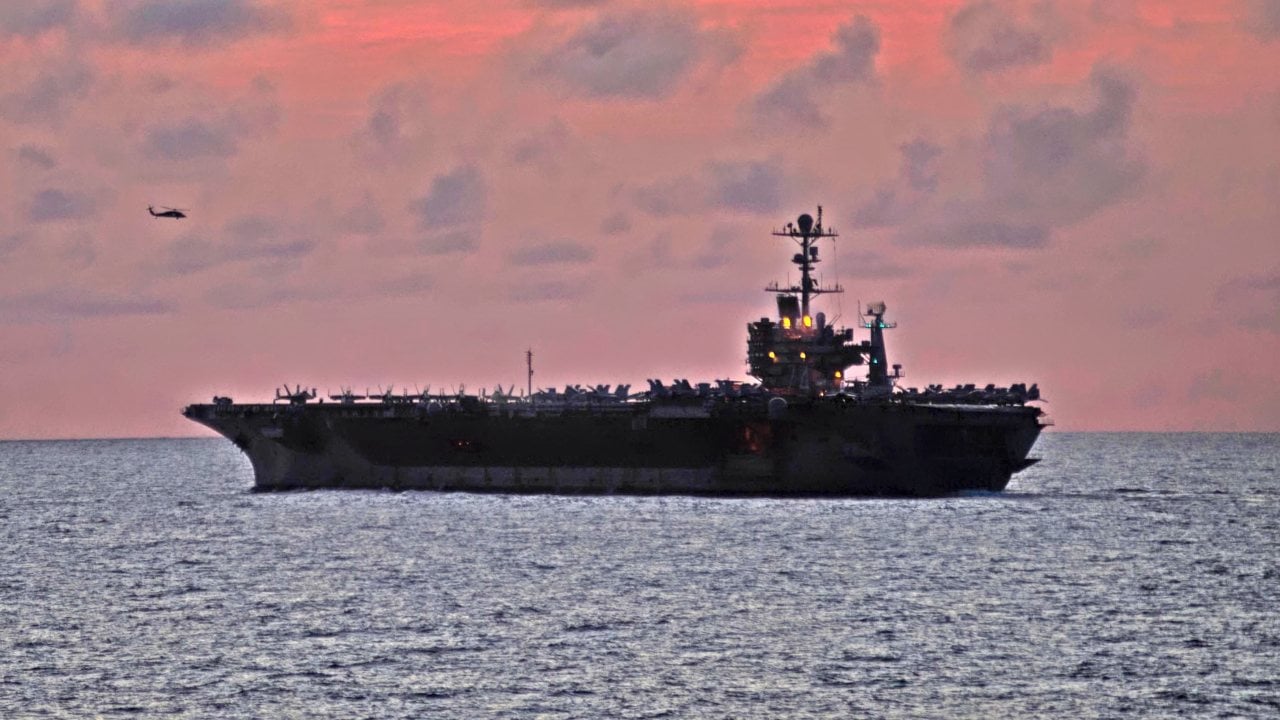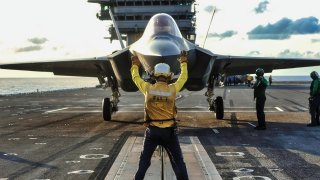Is China Wasting its Time Building Aircraft Carriers?
Even as Beijing has sought to develop "carrier killer" missiles – including its DF-21 and DF-26 – the People's Liberation Army Navy (PLAN) launched its third aircraft carrier last year.
Even as Beijing has sought to develop "carrier killer" missiles – including its DF-21 and DF-26 – the People's Liberation Army Navy (PLAN) launched its third aircraft carrier last year. When it becomes operational in 2025, it will mean that China, a nation that didn't have any operational carriers until a little more than a decade ago, will have the distinction of having the second-largest carrier force.
It would seem that the development of weapons to destroy carriers along with a fleet of flattops would seem to be mutually exclusive, at least in terms of objectives.
For one, China was able to develop the DF-26B – a dual-capable missile that was a type of weapon banned by the Intermediate-range Nuclear Forces Treaty signed by the United States and the Soviet Union near the end of the Cold War – as Beijing was never invited to join the agreement. However, the United States withdrew from that treaty during the Trump administration citing Beijing's deployment of such weapons as a justification.
The United States Navy currently operates 11 nuclear-powered supercarriers, including 10 of the Nimitz-class and one of the Gerald R. Ford-class. Over the coming decades, the aging Nimitz-class flattops will be replaced on a one-for-one basis with the newer and more advanced Ford-class.
Beijing may have the second largest carrier force on paper, but its Type 001 Liaoning is little more than a training carrier in terms of its capabilities, while the Type 002 Shandong is also essentially a "proof of concept" that the Chinese industry could build a carrier domestically. It was still based on its predecessor, and most naval analysts don't believe it is all that capable of a warship.
This brings the question of whether China is wasting its time and resources building carriers when it has developed the weapons to destroy the warships at sea.
Hedging Bets on Aircraft Carriers
The decision to build weapons to destroy U.S. – or any other adversaries' – carriers isn't mutually exclusive to the PLAN's carrier ambitions. The United States certainly has the weapons, including the airwings of its carriers as well as a fleet of ground-based bombers that could target an enemy carrier in wartime.
It should be remembered that the vast majority of aircraft carriers sunk in the Second World War were the victims of enemy aircraft. Of the dozen U.S. carriers sunk in that conflict, only two were lost to fire from surface ships, while one was disabled by aircraft first. Moreover, of the 22 Japanese carriers sunk during WWII, just one was sunk by a surface ship.
Carriers can destroy other carriers, just as tanks can destroy other tanks. Even as drones have shown to be quite effective, there is no reason to believe the U.S. will stop producing main battle tanks (MBTs).
Another factor – at least if Beijing is thinking of a conflict – is that its DF-21 and DF-26 can strike targets in waters close to China, they can't take the fight to an adversary.
Power Projection
Perhaps the bigger factor is that China doesn't simply want a place in the sun – to reference Germany's 19th-century desire for overseas colonies. Beijing wants a place on the world stage as a true superpower, and unlike the Soviet Union, it understands that this means a network of overseas ports and a fleet that can sail around the world's oceans.
The United States can deploy a carrier to global hotspots. Recently it was able to send carrier strike groups to the Mediterranean, the Persian Gulf, and South Korea at the same time. That is a power projection that Beijing and, really no other nation on Earth, has.
The United States Navy is solely able to respond to a crisis unlike any other naval force in the world because of its carriers.
"There is nothing that can compare to the flexibility and offer the capabilities of a carrier. It is not just for launching strike aircraft, there are all those other things it can do, ranging from humanitarian to disaster relief," Brad Curran, aerospace and defense industry principal analyst at Frost & Sullivan told this reporter for an article on the significance of aircraft carriers nearly a decade ago.
Nothing Curran said then is any less true today.
And if China desires to be front and center on the world stage, it will need aircraft carriers to get there.
Can China Afford It?
The question then isn't whether China is wasting its time, it is whether its investment in a navy, and notably aircraft carriers will pay off.
Beijing's desire to build the warships has only served to encourage India to build an indigenous carrier, while some in New Delhi have called for a fleet with at least four flattops. Japan has modified its two helicopter carriers to operate the Lockheed Martin F-35B Lightning II – resulting in the first Japanese carriers since World War II.

South Korea also continues to mull over a potential medium-sized carrier.
Moreover, instead of obtaining dominance in the Indo-Pacific, China's carrier ambitions have driven nations such as the Philippines and Vietnam closer to the United States. The U.S. has allies, including those with carriers, while China can't say the same.
Finally, China is facing a population implosion, and it could see its population decline by hundreds of millions by the end of the century, while its economy has been steadily slowing. Beijing's rush to build a world-class navy will mean it will have to maintain that large fleet, an increasingly expensive proposition in the best of times and one that it may struggle with in the coming decades.
Carriers aren't cheap to build, are expensive to operate, and are certainly inviting targets. China can't be a great power without them, but the biggest question is whether it can really afford them in the long term.
Author Experience and Expertise
Peter Suciu is a Michigan-based writer. He has contributed to more than four dozen magazines, newspapers, and websites with over 3,200 published pieces over a twenty-year career in journalism. He regularly writes about military hardware, firearms history, cybersecurity, politics, and international affairs. Peter is also a Contributing Writer for Forbes and Clearance Jobs. You can follow him on Twitter: @PeterSuciu.
All images are U.S. Navy/Flickr.


